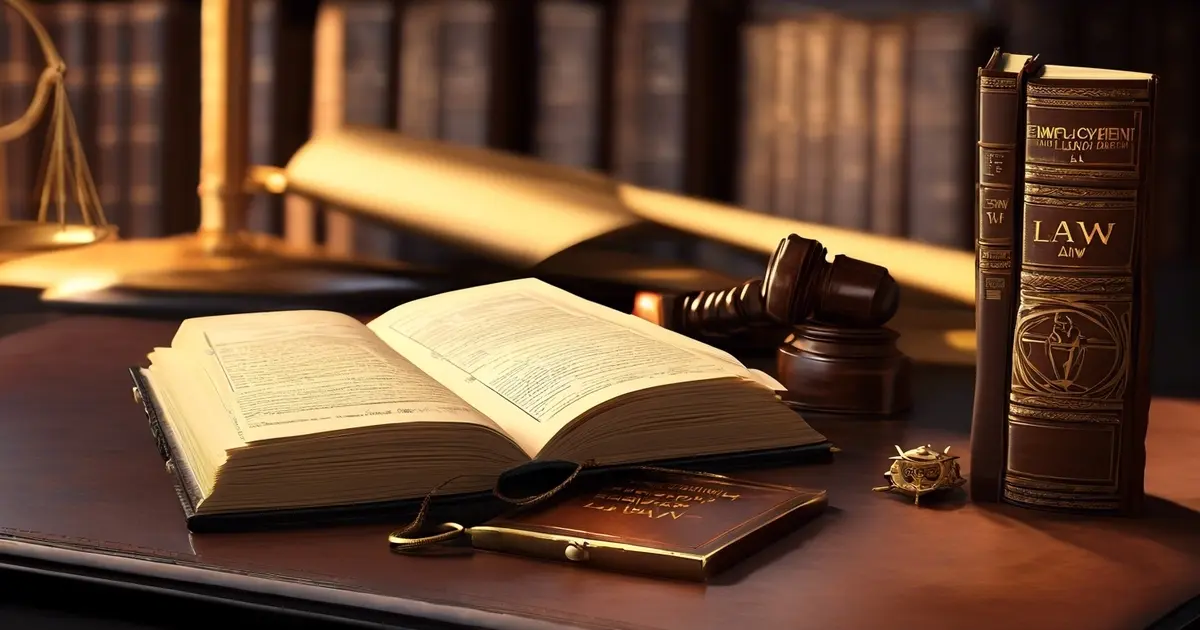Criminal Law Explained: A Comprehensive Guide to Its Principles
Have you ever wondered what keeps the wheels of justice turning? Criminal law, guided by the prosecutor and attorney, serves as the backbone, ensuring fairness and safety in society by evaluating the guilty mind and determining the appropriate sentence. This intricate criminal justice system, designed to address criminal offenses and impose penalties on those who violate the criminal code through criminal procedure, is fascinating and complex. It's a realm in criminal justice where precision meets passion, every detail counts, and every attorney knows that every case can set a precedent and every sentence can change a mind.
Whether you're entangled in its web or simply curious about how it operates behind the scenes, understanding criminal law, including states' perspectives on killing, mala in se crimes, and the defendant's role, is crucial. Dive into the depths of legal battles, rights protection, and the relentless pursuit of justice with us—it’s more than just courtroom drama; it’s about keeping our communities safe, upholding the principles of equity, and navigating the complexities of states, common law, and defendant issues.
Table Of Contents
Origin and Purpose of Modern Criminal Law
Ancient Roots
Criminal law has deep historical roots. It traces back to ancient codes, like Hammurabi's Code. These early laws set the groundwork for the justice systems in states we know today, focusing on the defendant's rights.
Ancient codes were strict. They often applied the "an eye for an eye" principle in standard law states. This meant that punishments mirrored the crime committed by the defendant. Over time, societies realized this common law approach could sometimes be milder. The need for a system, like common law, could adapt and change became apparent.
Modern Evolution
Modern criminal law aims to maintain public order and protect individual rights. It prescribes what is considered threatening, harmful, or endangering conduct. Laws are established by statute and enacted by legislatures across different jurisdictions.
The purpose of criminal law has evolved significantly over the centuries. Initially focused on punishment, it now also emphasizes rehabilitation of offenders. This shift reflects our society's growing understanding of human behavior and psychology.
Criminal procedure also plays a crucial role in this system—it authenticates crime commission and authorizes treatment of offenders based on proven guilt.
Societal Impact
Today's criminal laws address contemporary societal issues more than ever before. They vary by jurisdiction but share common goals: protecting public safety and ensuring justice is served while respecting individuals' rights.
For example:
- Cybercrime laws combat offenses committed online.
- Environmental regulations penalize pollution-related crimes. These adaptations show how criminal law evolves with society’s needs.
Distinction from Civil Law
It’s essential to understand how criminal law differs from civil law. Civil law deals with disputes between individuals or organizations where compensation may be awarded to the victim.
In contrast, criminal cases involve actions considered harmful to society—thus warranting governmental intervention.
Key Differences
- Criminal law focuses on punishing offenders; civil law aims at resolving disputes.
- Guilt must be proven beyond reasonable doubt in criminal cases; civil cases require a balance of probabilities.
Understanding Criminal Codes and Their Application
Legal Simplification
Codification of criminal laws is a crucial process. It turns complex legal principles into more straightforward, written codes. This makes the law more accessible to everyone, not just lawyers or judges.
By having laws written down, people can better understand what is illegal and the consequences of breaking these laws. For example, traffic violations are clearly outlined in most jurisdictions' codes. This helps drivers know what behaviors to avoid on the road.
Criminal codes also ensure consistency in how laws are applied across different cases. When judges interpret these statutes, they rely on the precise language provided by codification. This leads to fairer outcomes for individuals involved in legal proceedings.
Jurisdiction Variations
Criminal codes vary widely from one place to another. What's considered a crime in one country might be perfectly legal in another.
For instance, some countries have strict drug possession laws with severe penalties, while others have decriminalized certain substances altogether. These differences reflect cultural values and societal norms within each jurisdiction.
Understanding these variations is essential for anyone traveling or moving between regions. Ignorance of local criminal codes does not exempt individuals from facing legal repercussions if they violate local statutes.
Court Guidance
Courts use criminal codes as guides when deciding cases. These documents provide a framework for interpreting individual actions within the context of existing laws.
Judges look at the specific language within a code to determine if an action violates it. They also consider previous case precedents but always refer to the statute for final decisions.
This reliance on written law ensures that personal biases do not influence court outcomes significantly. It promotes justice based on established rules rather than subjective opinions.

Principles of Criminal Law and Its Objectives
Core Ideas
Criminal law operates on basic principles. It upholds legality, punishment, and prevention of harm. These ideals are crucial for a fair justice system.
Legality means that behaviors can only be criminal if laws exist against them before committing the act. This principle protects individuals from being charged unfairly for actions that were not previously defined as illegal. For example, you cannot be punished for something legal when you did it.
Punishment and prevention aim to deter people from committing crimes. They also seek to rehabilitate offenders so they can return to society as law-abiding citizens. The balance between these goals is delicate but essential.
Societal Balance
Criminal law strives to protect society while respecting individual freedoms. This balance is fundamental in democratic societies.
It uses rules and constitutional rights to ensure fairness in legal processes. Everyone accused of a crime has rights, such as the right to a fair trial and protection against self-incrimination.
The concept of strict liability in some areas shows this balance, too. In cases where intent doesn't impact guilt (like traffic violations), the law prioritizes societal safety over individual intent.
Deterrence & Rehabilitation
Two main objectives define criminal law: deterring wrongful conduct and rehabilitating offenders.
Deterrence works by setting examples through punishments like fines or imprisonment. The idea is simple: seeing others penalized discourages similar behavior. Rehabilitation focuses on changing offenders' behavior for their safety and society's safety upon release. Both strategies aim to reduce future offenses and contribute to overall public security.
Protection & Freedom
Ultimately, criminal law seeks harmony between protecting society and preserving individual freedoms.
This involves creating laws based on societal values reflected in the Constitution or other foundational documents. Criminal law ensures that no one can infringe upon another's rights without facing consequences. This dual focus helps maintain order while safeguarding personal liberties often taken for granted until threatened.
Classification of Crimes: Felonies and Misdemeanors
Serious Offenses
Felonies are the most severe category of criminal offenses. They include crimes like murder, rape, and armed robbery. People convicted of felonies face harsh penalties. These can range from lengthy prison sentences to even the death penalty in some jurisdictions.
The seriousness of felonies affects the penalties and how trials are conducted. For example, defendants have more rights during felony trials. This is because the stakes are much higher for them.
Lighter Sentences
Misdemeanors involve less severe crimes compared to felonies. Common examples include petty theft and public intoxication. The penalties for misdemeanors are lighter than those for felonies. Often, they involve short jail terms or fines rather than long-term imprisonment.
The distinction between misdemeanors and felonies also influences trial procedures. Misdemeanor trials tend to be quicker and less formal than felony trials.
Understanding the difference between these two categories is crucial in criminal law:
- Felonies: Serious offenses with severe consequences.
- Long-term imprisonment
- Potential death penalty
- More complex trial procedures
- Misdemeanors: Less severe crimes with milder consequences.
- Short jail terms or fines
- Quicker, less formal trials
This classification impacts everything from how a case is handled in court to what kind of punishment someone might receive if found guilty.
Elements of a Crime: Actus Reus and Mens Rea
Actus Reus
Actus reus, or the physical act of a crime, is crucial. It's about what someone did or didn't do that breaks the law. For example, if someone takes another person's property without permission, their action constitutes theft.
The law looks at actions closely. Not just any action counts as actus reus. The action must be unlawful and voluntary for it to matter in court. This means the person had control over their actions when they committed the crime.
Mens Rea
Mens rea deals with the mental state behind a crime. It’s about whether someone meant to commit a crime or knew what they were doing was wrong. Intent plays a big part here.
There are different levels of mens rea, from intending harm to being reckless or negligent. If someone plans and carries out an assault knowing it is wrong, that shows clear intent.
Both elements together form the foundation of criminal responsibility under criminal law.
To convict someone of a crime, actus reas and mens rea must be present beyond reasonable doubt. This dual requirement ensures fairness in legal proceedings by providing clear standards for guilt.
In considering felonies and misdemeanors discussed earlier, these elements also play vital roles in classification. For serious crimes (felonies), proving intent can significantly impact sentencing outcomes.
Understanding these concepts helps us understand how crimes are judged differently based on actions and intentions. Knowing this can help individuals understand why some cases result in harsher penalties.
By combining insights into actus reas and mens rea, one gains comprehensive knowledge on determining criminal responsibility. This understanding underscores the complexity inherent in prosecuting crimes within our legal system.
Different Types of Crimes Explained
Violent Crimes
Violent crimes are actions that cause harm to individuals. They include murder, assault, and robbery. These crimes often result in severe legal consequences.
Violent acts directly impact victims' physical well-being. Law enforcement prioritizes these due to their immediate danger. Understanding violent crimes helps tailor prevention strategies effectively.
Property Crimes
Property crimes involve the theft or destruction of someone's property. Burglary, theft, and arson fall under this category. Unlike violent crimes, they don't always involve physical harm.
These offenses affect financial stability and emotional peace. Strategies against property crime focus on safeguarding assets and increasing surveillance.
White-Collar Crimes
White-collar crimes are financially motivated non-violent offenses committed by business professionals. Fraud, embezzlement, and insider trading are examples. They have complex implications for the economy.
The challenge lies in their detection because they're often hidden within legitimate activities. To combat them requires specialized investigative skills and an understanding of financial systems.
Cybercrimes
Cybercrimes use technology to commit offenses against individuals or organizations. Examples include hacking, identity theft, and cyberbullying. They pose unique challenges due to their anonymous nature.
Preventing cybercrime demands up-to-date technological defenses and public awareness campaigns about online safety practices.
The Criminal Process: From Police Investigation to Sentencing
Police Investigation
The journey through the criminal process often starts with a police investigation. Law enforcement officers look into alleged crimes. They gather evidence and identify suspects.
During this phase, police officers work tirelessly. They interview witnesses and collect physical proof. Their goal is to build a strong case for the prosecution. This stage is critical because it sets the foundation for everything that follows in a criminal case.
Arrest and Charges
After gathering enough evidence, an arrest may occur. The suspect gets taken into custody by law enforcement officials.
Following the arrest, formal charges are usually filed by a prosecutor. This marks the beginning of the criminal trial process in court systems. At this point, defendants learn what they're being accused of officially.
Prosecutors play a crucial role here. They decide on the charges based on available evidence. Their decisions can significantly impact how cases proceed in court.
Trial Phase
A criminal trial is where guilt or innocence is determined. Defendants have rights, including legal representation and presenting their defense.
Trials involve several steps:
- Selection of jurors
- Opening statements by both sides
- Presentation of evidence
- Witness testimonies
- Closing arguments
- Jury deliberation
The outcome hinges on whether there's "beyond reasonable doubt" about the defendant’s guilt.
Conviction or Acquittal
If found guilty, defendants face sentencing. An acquittal means they are free to go without any punishment from penal laws.
Convictions lead to another crucial part: sentencing hearings. Judges consider various factors before deciding on appropriate sentences.
These factors include:
- Crime severity
- Defendants' records
- Impact on victims
Sentences can range from probation to imprisonment, depending on these considerations.
Sentencing Guidelines
Sentencing varies widely across different jurisdictions due to specific guidelines each has established under its penal law system.
Some common forms of punishment include:
- Fines
- Community service
- Probation terms
- Jail time
Courts aim for sentences that reflect crime gravity while also considering rehabilitation possibilities for offenders.

Defenses in Criminal Law and Rights Protection
Common Defenses
In criminal law, defendants often use certain defenses to argue their case. These include insanity, self-defense, and duress. Each defense has its unique criteria and implications.
Insanity as a defense is complex. It requires proving that the defendant was unable to understand the nature of their actions or distinguish right from wrong due to mental illness at the time of the crime. This does not mean they are free from consequences, but it may lead to treatment rather than prison.
Self-defense is another widely recognized defense. It justifies using force to protect oneself from imminent harm. The key here is "imminent". You can't claim self-defense for a perceived future threat.
Duress involves committing a crime because someone threatened you with serious harm if you didn't comply. However, this doesn't work for all crimes; for example, it's rarely accepted in murder cases.
Rights Protection
The legal system greatly emphasizes protecting a defendant’s rights throughout the criminal process. This protection starts from arrest through trial, ensuring fairness and justice are upheld.
One core principle is the presumption of innocence until proven guilty beyond reasonable doubt. This means everyone deserves their day in court without being treated as guilty beforehand. Defendants also have the right to remain silent, avoiding self-incrimination during police interrogations or trials.
Another critical aspect is access to legal representation. Regardless of financial status, defendants have the right to an attorney who can defend them effectively against charges.
These protections prevent wrongful convictions by providing checks and balances within our judicial system. They ensure that only those genuinely responsible face punishment while safeguarding individual freedoms.
By understanding these defenses and rights protections in criminal law, individuals can better navigate potential legal challenges while appreciating our system's efforts toward fair treatment for all involved.
International vs. National Criminal Law: A Comparative View
Jurisdiction Differences
Jurisdiction is a crucial difference between international and national criminal law. International law operates across borders. It deals with crimes that affect multiple countries or the global community. Examples include genocide and terrorism. National law, on the other hand, applies within a country's borders.
International courts like the International Criminal Court (ICC) handle cases under international law. They need cooperation from nations to enforce rulings. National courts deal with domestic crimes based on their country's laws.
Enforcement Mechanisms
Enforcement in international criminal law can be challenging. This is because it relies on countries working together. Some nations might not recognize an international court’s authority or choose not to cooperate.
National criminal law has precise enforcement mechanisms within its territory. Police forces arrest offenders, and national courts prosecute them based on local laws.
Applicable Laws
The applicable laws also differ significantly between these two realms of criminal justice.
- International laws focus on protecting human rights and ensuring peace among nations.
- Crimes against humanity
- War crimes
- National (domestic) laws address offenses committed within a single nation.
- Theft
- Murder
- Drug trafficking
Countries adopt different legal systems, such as civil or common law systems, influencing how national laws are applied.
United States Example
In the United States, federal and state systems demonstrate how national legal frameworks operate independently yet cohesively to address various offenses ranging from minor infractions to severe felonies.
Contrastingly, when dealing with issues like human trafficking that cross borders, both U.S. domestic agencies and international bodies may become involved, highlighting the interplay between national and international legal principles in combating global crime.
Understanding these distinctions helps clarify why certain cases fall under one jurisdiction over another—offering insights into complexities surrounding global justice efforts post-discussions about "Defenses in Criminal Law and Rights Protection."
Summary
Diving into the world of criminal law, you've journeyed through its foundations, explored the nuts and bolts of criminal codes, and untangled the complex web of principles, classifications, and processes that define it. You've peeked behind the curtain at the drama of crimes, defenses, and the pivotal moments from investigation to sentencing. It's a realm where the stakes are high, and the outcomes can change lives. With this knowledge, you're better equipped to navigate legal dilemmas or engage in more informed debates around your dinner table.
But don't stop here. The landscape of criminal law is ever-evolving, shaped by societal shifts and groundbreaking cases. Keep your curiosity piqued. Dive deeper into specific areas that caught your eye, or stay abreast of new developments in this fascinating field. Your understanding empowers you and enriches the conversations and communities you're part of. Let's keep learning together.
Frequently Asked Questions
What is the primary purpose of modern criminal law?
The main goal of modern criminal law is to maintain public order and safety by deterring wrongful conduct, punishing offenders, and rehabilitating them. It's like setting ground rules for a game where everyone knows what's off-limits.
How do criminal codes apply to different crimes?
Criminal codes act as rulebooks that categorize various offenses and outline penalties. Think of it as a cookbook where each recipe represents how to handle different crimes, from theft to assault.
What are the key principles behind criminal law?
Criminal law operates on principles like fairness, justice, and equality. It aims to balance society's need for protection with respect for individual rights—like ensuring every player gets a fair shot in a game.
Can you explain the difference between felonies and misdemeanors?
Sure! Felonies are serious crimes—think grand theft or murder—that usually carry hefty penalties. Misdemeanors are lesser offenses, such as jaywalking or petty theft, with lighter consequences. Imagine felonies as major fouls and misdemeanors as minor infractions in sports terms.
What do "actus reus" and "mens rea" mean in criminal offense elements, referring to the guilty act and guilty mind, respectively, in the criminal code and procedure?
"Actus reus" refers to the actual act of committing a crime, while "mens rea" involves the intent behind it. Picture "actus reus" as pulling the trigger, whereas "mens rea" wants to fire the gun—a crime typically needs both parts.
Could you describe some types of defenses used by an attorney in criminal law against prosecution for serious offenses?
Defenses can range from proving innocence (an alibi) to demonstrating a lack of intent (insanity defense). It’s akin to showing that you didn’t break the vase and that if it seemed so, there was no intention or capability on your part due to circumstances beyond your control.
How does international criminal law differ from national laws?
International criminal law deals with crimes affecting global peace and security—like genocide or war crimes—across borders. National laws focus on domestic issues within a country’s boundaries. Think global versus local soccer rules; similar fundamentals but different scopes.
Related Post
Immigration Law
Immigration law, a complex web of issues including naturalization that has evolved significantly over centuries, is one of the most discussed topics worldwide, particularly in the United States, affecting numerous persons.
Read MoreEmployment Law
Did you know that over 60% of Americans know their rights and responsibilities under employment law, including specific jobs, minimum wages, federal minimum, and unions?
Read MorePersonal Injury Law
Navigating the complexities of personal injury law, court decisions, and alternative dispute resolution can feel like trying to find your way out of a labyrinth without a map for the injured party, emphasizing the importance of reasonable care.
Read MoreCorporate Law
In the fast-paced world of modern corporations and businesses, understanding corporate law, limited liability, and company structure can feel like reading a map with no legend for many corporations.
Read MoreEstate Law
Encompassing guardianship, court power, and litigation, estate law might seem like a tangled web of confusing terms and endless paperwork.
Read MoreFamily Law
We have always wondered how the tangled web of family dynamics can be legally navigated in many states and articles worldwide through committees.
Read More






